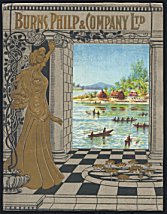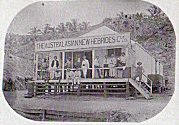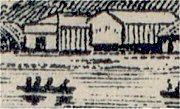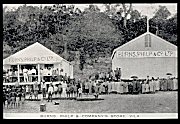
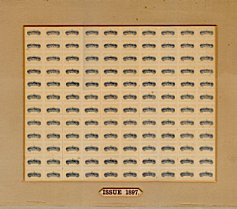
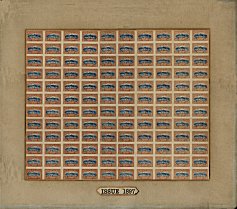
|
These frames of the 1897 stamps, which were arranged in the form of a complete sheet, hung on the wall of a Burns Philp & Co. Ltd. office in Sydney for some decades. Hals / Collas wrote about these "sheets" : "Mr. Ankin (J. Chas. Ankin, a director of John Sands Pty., Ltd. did a lot of research for Hals/Collas in Sydney) obtained permission to remove the frames from the office wall of Burns, Philp. These sheets turned out to have been put together from six (sic!) vertical pieces of 24 stamps each".
Having these plates in hand, I can correct this a bit as they are composed of 5 x 24 = 120 |
Following the cessation of the subsidized Australasian United Steam Navigation Company (AUSN) service in March 1893, the Australasian New Hebrides Company (ANHC), took on the responsibility for handling mails for the NSW Postal Agency, the local manager being appointed postal agent. In May 1893 ANHC received a subsidy of £600 from the Missions to provide a connection to Sydney 3 times per year. The ANHC followed the previous system of an inter-island vessel connecting monthly to an ocean going steamer. By enlarge the inter-island service was provided by a small steamer chartered from AUSN and in addition AHNC paid AUSN an further amount to deviate the Sydney/Fiji service to Vila. In 1896, the ANHC issued their own commercial notes. . The contract with the Missions was expanded to provide 6 trips per year and included landing and receiving mail at each Mission station. By 1897, because of changes in trade and increased competition by the French and their well-subsidised shipping, the Company decided to charge for delivering letters between the islands, Vila and Sydney. Various constructions have been placed on the correspondence between Burns Philp and the NSW Post Office in connection with the proposed use of the locals. Enthusiasts are encouraged to read the extracts of this correspondence which can be found on pages 31 & 32 of Hals & Collis and form their own opinions. Two stamps had already been printed for the purpose. They were issued on 17 March 1897 (although a used copy dated 9 March is known). |
The Company eventually failed, with Burns, Philp & Co. Ltd. taking over its assets, including the remainders of the stamps, on 30 September 1897. On 1 September 1900, Burns, Philp & Co. Ltd. took on a 10-year subsidised agreement to carry cargo and mail, and the use of the locals was specifically forbidden under the terms of the subsidy. The Government of the Commonwealth (the initial contract was with the NSW government) and the Presbyterian Mission both contributed a subsidy. The remainders of the locals (140,000 1d, 94,000 2d) were sold by tender in 1913 to Thomas Henry Nicoll, a Sydney stamp dealer. There is no doubt that these locals were genuinely issued to prepay postage. However, there are relatively few used singles bearing cancellations dated prior to August 1897, and no commercial covers are known. Copies dated after 30 September 1897 are likely to be philatelically used. "The islands called at were Anietyum (Aneityum), Aniwa, Aoba, Aurora, Epi, Erromanga, Futuna, Mai, Nguna, Pentecost, Tongariki, Tonga (Tongoa), Sandwich and Vannaleva (Vanna Luava), also at times other islands, notably in the Santa Cruz, Banks' and Torres' groups. from: "Billig's Philatelic Handbook", Volume 04, page 205, the names in brackets are those Hals/Collas use on page 39. Following further research it can now be said that when Burns Philp took over ANHC's assets they retained the Mission contract which continued to provide for the landing and receiving of mail at each Mission station. In 1898 Burns Philp was awarded a subsidy connected with their New Hebrides service, to call at Lord Howe and Norfolk Islands. There is no reference to this contract banning the use of the locals. The use of the locals is known to have continued until December 1900. |
Burns, Philp & Company, Ltd.
Below at left the Vila ANHCo building in 1897, at right the same building in 1900.
The bottom picture is a blowup from the stamp: not so far away from reality I think.
At right: cover of a BP book issued in 1903.
Source: the two b/w pictures: "Pirating the Pacific", Powerhouse Museum, Sydney,1993.
The color picture: "All about Burns, Philp & Company, Limited, Their Shipping
Agencies, Branches & Steamers. John Andrew & Company, Sydney, for Burns,
Philp & Co. Ltd., 1903. (Klinger coll.)

